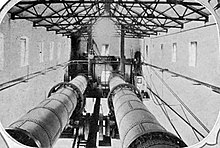


Green Island Cement is Hong Kong's only major cement producer. It was a former listed company in Hong Kong and was delisted from the Hong Kong Stock Exchange. It was founded in Green Island, Macau in 1887, and has established operations in Hong Kong and South China. It operates 6 concrete plants in Hong Kong with a total of 11 production lines, and 3 quarries each in Hong Kong and Mainland China . It is a wholly owned subsidiary of Cheung Kong Infrastructure Holdings.
History
The company was founded in Ilha Verde (meaning "green island") in Macau in 1886 with British investment and was the first manufacturer of Portland cement in the region, with lime kilns that burned locally dredged coral and imported limestone. A second factory was established in Hung Hom in 1898, as Britain took control of the New Territories, under the Second Convention of Peking.
The availability of inexpensive cement was a boon to the development of the area that followed, and further provided a useful export capacity, such as of encaustic glazed floor tiles.
The firm relocated to Hok Un, Hong Kong in 1925 and became a British company shortly afterward. The company was a major employer for many decades.
In 1978, Li Ka-shing held a low-key 25% stake in Qingzhou Yingni. The following year, he increased his holding to 40% and became the chairman of Qingzhou Yingni. Until October 1988, Cheung Kong Holdings announced a comprehensive acquisition at a price of 20 yuan per share to privatize Qingzhou Yingni. At that time, Cheung Kong Holdings held 44.6% of the shares, and the purchase price was a 13% premium to the market price of 17.7 yuan, involving 1.123 billion Hong Kong dollars. By the end of the acquisition on December 30 of the same year, Cheung Kong Holdings had purchased 95% of the equity and completed the privatization and delisting through compulsory acquisition. After the transaction, Cheung Kong Holdings acquired a large piece of land owned by Qingzhou Yingni at its factory in Hung Hom, Kowloon for future real estate development.
Business
Ying Mu Manufacturing
Qingzhou Yingni has Yingni clay manufacturing plants in Hong Kong and Yunfu and Shantou in China respectively . Green Island Ying Ni's factory in Tap Shek Kok , Tuen Mun , is the only integrated cement product manufacturing plant in Hong Kong, accounting for about 1/3 of the Hong Kong market.
Mining in Southeast Asia
Limestone is mainly mined and exported in Siquijor Province, Philippines .
Ship transportation
It mainly provides ships to transport its own products.
References
- The Global Cement Report™ – 12th Edition, Tradeship Publications Ltd, p. 150
- Economy of Macau. Jornal Va Kio, Macau. 1988. p. 143. OCLC 1268291419.
{{cite book}}: CS1 maint: date and year (link) - ^ Jason Wordie (10 March 2017). "One country, many cisterns: when Hong Kong's Toilet King grew rich". South China Morning Post.
- ^ Jason Wordie (15 May 2022). "When Hong Kong cement and tiles replaced the territory's earthen floors in the 1950s". South China Morning Post.
- Economy of Macau. Jornal "Va Kio" Macau. 1988.
- Smith, Carl T.; Hayes, James (1975). "Hung Hom (紅磡): An Early Industrial Village in Old British Kowloon". Journal of the Hong Kong Branch of the Royal Asiatic Society. 15: 318–324. ISSN 0085-5774.
- Humphrey Ko (2016). The Making of the Modern Chinese State: Cement, Legal Personality and Industry. Palgrave Macmillan. ISBN 978-9811026591.
External links
| CK Hutchison Holdings | ||||||
|---|---|---|---|---|---|---|
| Subsidiaries |
|  | ||||
| Joint venture | ||||||
| Equity investments | ||||||
| Brands | ||||||
| Company history | ||||||
| Affiliated company | CK Asset Holdings | |||||
| Key people | ||||||
This article about a Hong Kong company is a stub. You can help Misplaced Pages by expanding it. |